How one LAW can Finance big Scale Seasteading
Jones Act
The Merchant Marine Act of 1920 (P.L. 66-261), also known as the Jones Act, is a United States federal statute that provides for the promotion and maintenance of the American merchant marine. Among other purposes, the law regulates maritime commerce in U.S. waters and between U.S. ports.
What started off as a good idea soon lead to a burden, as so many laws do. While the Jones Act is trying to lead to better organisation and better security for sailors, it also granted monopoly for US ship builders. The reason for this is that the law needs ships, shipping cargo between US harbors, need to comply to the Jones act.
Jones Act compliant ships must be:
- manned by US citizens
- US build
- US owned
- Fly the US flag
Problem
Cheaper, bigger and probably higher quality Asian ships from Japan, Korea and China can thus only be used to deliver freigt into a US harbour before leaving to another country. This is already a high burden on the customer, as US ship cost 5 times as much as Asian ones, are less clean and there is no ability to build the as big as the Koreans can.
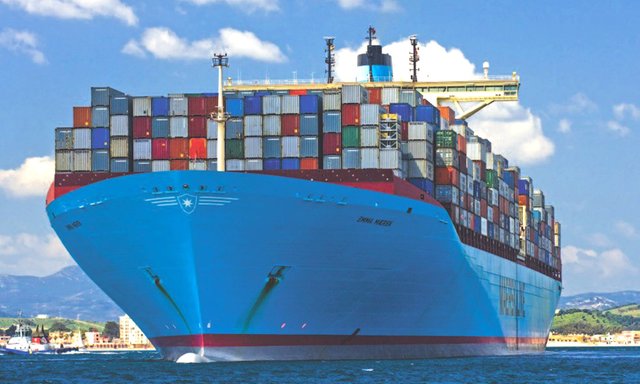
The Emma Mærsk launched in 2006 was the biggest container ship with 11000 TEU (twenty-foot equivalent units). The biggest container ships right now are the Maersk Triple E class with 18,340 TEU
Increasing costs are crippling Hawaii, Guan, Alaska and Puerto Rico. While the US main land can rely on cargo trains and trucks to drive the missing miles, Hawaii needs to be supplied by ship from the main land. It could be supplied directly from asia, but the foreign ship would then be forbidden to continue to mainland US.
We recently attempted to order a cabinet from a Seattle furniture dealer, priced at $1,133.
Shipping in the contiguous states was $211, but to Hawaii the cost was $988, almost the cost of the item.
Although the cabinet was made in Taiwan, it could not be off-loaded in Hawaii but rather had to be shipped to the West Coast, then loaded onto an American ship for the costly backward journey to Hawaii.
Welcome to the 1920 Jones Act, which mandates that all goods — even from Asia — be shipped to the islands by expensive American-built, -owned, -flagged and -crewed ships.
So there are some numbers:
| Taiwan -> Seattle | $ 211 |
|---|---|
| Taiwan -> Seattle -> Hawaii | $ 988 |
Prices on Hawaii are up to 4x over average, and that for all imports. Over the years, the total Hawaii imports from the U.S. between 2014–2015 decreased by 29.5 %.
For Puerto Rico it doesn't look better.
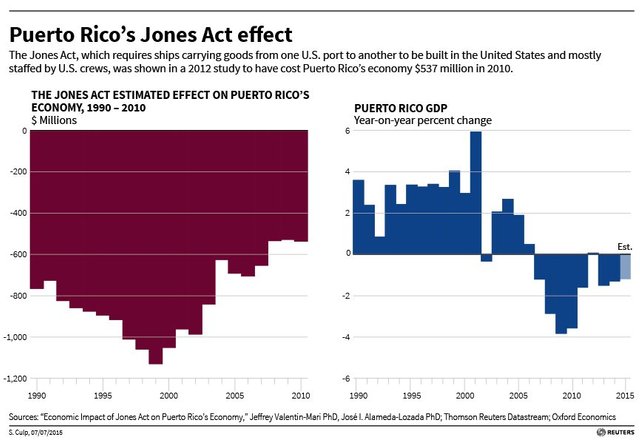
Point given: their spending itself is pretty bad too and puts an additional burden on the economy.
Solution
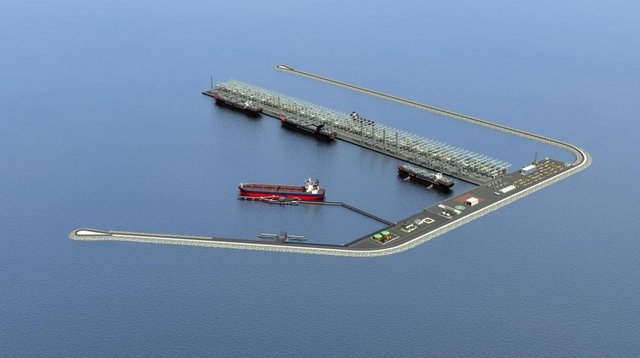
A concept for a floating harbour in front of Venice
A non-state offshore harbour in the international waters at Hawaii could be a solution.
The following pros and cons could be listed:
| Pro | Con |
|---|---|
| It could be used by all ships | Needs protection against storms and collision |
| Size constrains only limited by Cranes | Can sink |
| Trading route: Asia -> North pazific -> US -> Hawaii -> Guam -> Asia | Possible regulations |
| Concept can be reused in many places | May be entirely dependend on Jones Act |
Where to start
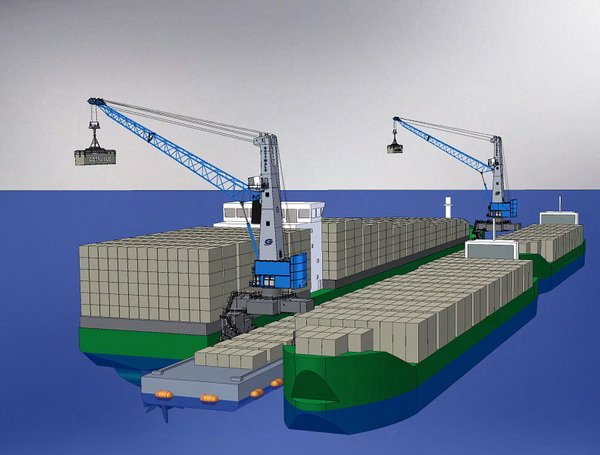
A concept from the Transport Research Institute, Edinburgh Napier University
The minimum viable product could consist of a special vessel, that pics up freight from ships on their way to Asia. The ships can earn a little money to do the trips in competition with the expensive Jones Act vessels and would be lighter for the rest of the way back to Asia. The freight could then be picked up by smaller ships to be delivered to Hawaii.
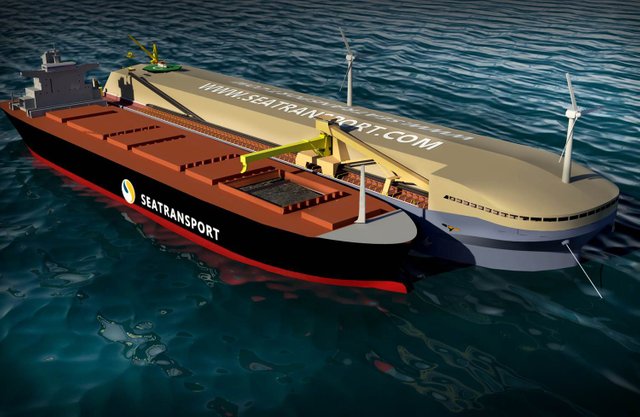
A concept by the Australian Maritime College
First use in front of Hawaii would be attractive because it would enable a big shipping route: the ships travel over the north Pacific to the US, and back over Hawaii and Guam to Asia.
With increasing traffic, a permanent floating harbour can be build that can be expanded continuously to fit the demand. The knowledge gained can then be used to build offshore harbours all over the world.
After this trial, it could be applied to Alaska, Guam, Puerto Rico and even in front of the US coast. Maybe even in front of other countries, if the concept of a offshore drop off point would make it more efficient for ships to deliver cargo.
Since a ship gets more efficient with the size, an offshore harbour network would enable enormous ships driving only on the pacific.
Commentary
After seeing a lot of projects intruducing all different kinds of seasteading, one question stayed:
"Why would somebody live there?"
Maybe we are still lucky that political reasons are not still good enough for such an endevour, but this also means that it has to get much worse before such a project is started. In that case it could already be too late.
But if people can earn money with seasteading, than it will be build way faster. Humans need an incentive to live in a hostile environment, then they find out how it can be done, not the other way round. This is why there are people living in the Antarctic, lower orbit, deserts and a lot already at sea.
To build a city on the sea, you need to have a reason for a whole city to move there. The opportunities opened up by the Jones Act could be such a reason.
Sources:
http://archive.northsearegion.eu/files/repository/20130228132250_Readversion-FCSTT.pdf
https://www.census.gov/foreign-trade/statistics/state/data/imports/hi.html
http://new.grassrootinstitute.org/2015/12/hawaiis-jones-act-costs-and-misconceptions/
http://thegardenisland.com/news/opinion/editorial/jones-act-is-costly-for-hawaii/article_521e9f1a-bd82-11e4-8701-1b042d4c5b08.html
http://www.businessinsider.com/r-us-shippers-push-back-in-battle-over-puerto-rico-import-costs-2015-7
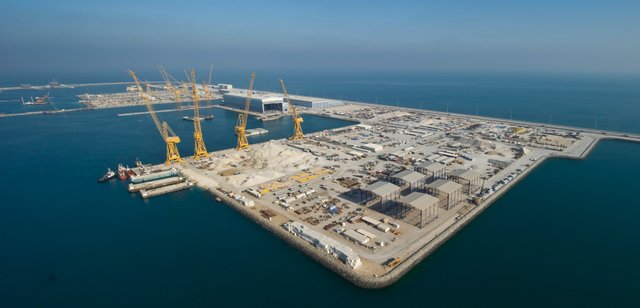
The Millennial Project by Marshal Savage
https://www.amazon.com/Millennial-Project-Colonizing-Galaxy-Eight/dp/0316771635/ref=mt_paperback?_encoding=UTF8&me=
the Aquarius Project, floating cities at sea, built with such redundancy, sinking is never a threat.
Looks interesting.
Thanks for sharing!
As an update: the magnesium mesh and high voltage technique to cause dissolved mineral accretion
(the SEAment) process was investigated and found to not build up fast past a certain thickness. The efficiency drops at something like 1/4inch or so, and to get 1/2 inch takes much longer. Other building processes should be considered for the initial construction phase. 3D printed triangular panels with locking edges are available, they create a tesselated dome or ovoid or tube... etc.
The hexagonal cells are the obvious way. Each single massive flotation body, linked together on all six sides supporting the structure as a whole, provides a level of redundancy unattainable any other way. This would keep a city many miles wide as safe and secure as any megalithic structure from paleo times. Seriously, these cities could survive for millennia. No problem.
His central tower idea fascinates me.
And keep in mind the depth of the floating cells create a basement level for the city.
Submerged habitats fixed to the underside could be built.
The possibilities are limited only by imagination.
The breakwater, the beaches, the fruit tree orchards built behind the breakwater
And the city surrounded by salmon, crab, oyster, clam, lobster, shrimp, etc, farms.
Shallow sea ponds, stretching out from the city to the breakwater.
He even attempts to calculate the profitablility of running such a massive seafood farming opperation, in 1993 prices. No joke, this book - and especially the first chapter which is all I've covered here - is a MUST read.
Not sure about the OTEC power plant tech, I know the University of Hawaii had one in operation, may still, I don't know. I read it was used for powering the university as well as the island's emergency response infrastructure.
The Discover mag article I read back in the 90s gave the tech high praise. The professor that was heading that project had some of the cold water uptake (from 2500 feet below) siphoned off to pipes that ran under the soil in his garden, and cooled it sufficiently enough that he could grow strawberries in Hawaii. He was proud of that I recall.
Take care.
I'd imagine creating a movable seastead could provide more freedom and property rights than living on the mainland
electric power solutions need to be considered.
And moving requires fuel.
The flexibility is indeed a great benefit!
I like this post. Cheers mate. All aboard. I was worried at first you were going to go all statist on me and try to be an American on a SeaSteading ship. Way to turn the corner. I had some thoughts on this too:
https://steemit.com/liberty/@aggroed/eff-this-place-let-s-buy-a-cruise-ship-and-start-a-new-country
Cruise ships are a great way to get living space on waters. But the main point I wanted to deliver was that there first needs to be an incentive. If there are millions to earn buy buildong a seasteading on the pacific, it will be done somehow.
Btw. there was an article that wen't through a thought experiment: a cruise line was declaring itself its own nation, moving all national offices onto their ships and declared the ships being each a moving state.
Too bad I can't find it anymore.
the profits from building shallow ponds at sea, to farm oyster, lobster, crab, ... would bring in billions and feed many millions.
Any permanently buoyed structure at sea would be a fine spot to farm immense amounts of high value sea food. And would immediately put a big dent in the industries currently raping the oceans.